#biorescue
Text
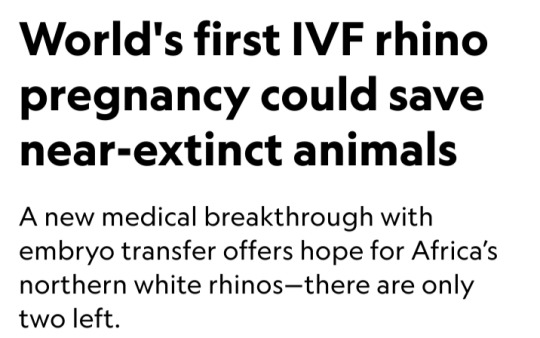

By Dina Fine Maron
January 24, 2024
Scientists have cleared a significant hurdle in the years-long effort to save Africa’s northern white rhinoceros from extinction with the first-ever rhino pregnancy using in vitro fertilization.
The lab-assisted pregnancy, which researchers will announce today, involved implanting a southern white rhino embryo in a surrogate mother named Curra.
The advance provides the essential “proof of concept” that this strategy could help other rhinos, says Jan Stejskal of the BioRescue project, the international group of scientists leading this research.
Curra died just a couple months into her 16-month pregnancy from an unrelated bacterial infection, Stejskal says.
However, the successful embryo transfer and early stages of pregnancy pave the way for next applying the technique to the critically endangered northern white rhino.
The process was documented exclusively by National Geographic for an upcoming Explorer special currently slated to air in 2025 on Nat Geo and Disney+.
BioRescue expects to soon implant a northern white rhino embryo into a southern white rhino surrogate mother.
The two subspecies are similar enough, according to the researchers, that the embryo will be likely to develop.
Eventually, this approach may also help other critically endangered rhinos, including the Asian Javan rhinoceros and the Sumatran rhinoceros, which each now number under 100 individuals, Stejskal says.
But the northern white rhino’s current situation is the most pressing by far.
There are no males left, and the only two remaining animals are both elderly females that live under armed guard on a reserve in a 700-acre enclosure in Kenya called Ol Pejeta Conservancy.
The boxy-jawed animals once roamed across central Africa, but in recent decades, their numbers have plummeted due to the overwhelming international demand for their horn, a substance used for unproved medicinal applications and carvings.
Made from the same substance as fingernails, rhino horn is in demand from all species, yet the northern white rhino has been particularly hard-hit.
"These rhinos look prehistoric, and they had survived for millions of years, but they couldn’t survive us,” says Ami Vitale, a National Geographic Explorer and photographer who has been documenting scientists’ efforts to help the animals since 2009.
“If there is some hope of recovery within the northern white rhino gene pool — even though it’s a substantially smaller sample of what there was — we haven’t lost them,” says conservation ecologist David Balfour, who chairs the International Union for the Conservation of Nature’s African rhino specialist group.
Blueprints for rhino babies
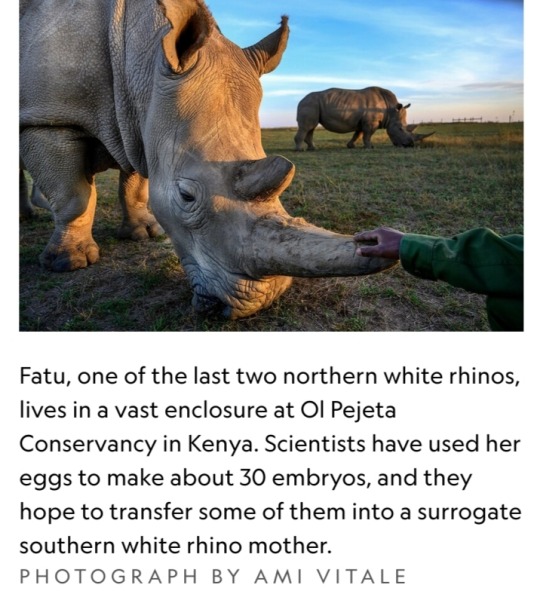
To stave off the animal’s disappearance, BioRescue has used preserved sperm from northern white rhinos and eggs removed from the younger of the two remaining females.
So far, they’ve created about 30 preserved embryos, says Thomas Hildebrandt, the head scientist of BioRescue and an expert in wildlife reproduction based at the Leibniz-Institute of Zoo and Wildlife Research in Berlin.
Eventually, the team plans to reintroduce northern white rhinos into the wild within their range countries.
“That’d be fantastic, but really, really far from now—decades from now,” says Stejskal.
Worldwide, there are five species of rhinoceros, and many are in trouble.
Across all of Africa, there are now only about 23,000 of the animals, and almost 17,000 of them are southern whites.
Then there are more than 6,000 black rhinos, which are slightly smaller animals whose three subspecies are critically endangered.
In Asia, beyond the critically endangered Javan and Sumatran rhinos, there’s also the greater one-horned rhino, whose numbers are increasing and currently are estimated to be around 2,000.
The BioRescue effort has experienced many setbacks, and even though the team now has frozen embryos, the clock is ticking.
The researchers intend to use southern white rhinos as surrogate moms for the northern white rhino embryos.
However, scientists want any northern white rhino calves to meet and learn from others of their kind, which means they need to be born before the two remaining females die.
“These animals learn behaviors — they don’t have them genetically hard-wired,” says Balfour, who’s not involved with the BioRescue work.
But birthing new animals in time will be a challenge.
“We’re really skating on the edge of what’s possible,” he says, “but it’s worth trying.”
Najin, the older female, will be 35 this year, and Fatu will be 24.
The animals, which were born in a zoo in the Czech Republic, are expected to live to about 40, says Stejskal, who also serves as director of international projects at the Safari Park Dvůr Králové, the zoo where the animals lived until they were brought to Kenya in 2009.
Impregnating a rhino
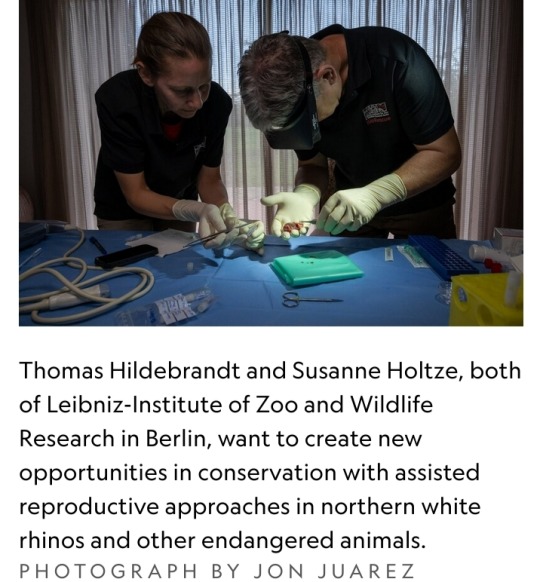
The next phase of BioRescue’s plan involves implanting one of their limited number of northern white rhino embryos into a southern white rhino surrogate mother — which the group plans to do within the next six months, Stejskal says.
They’ve identified the next surrogate mother and set up precautions to protect her from bacterial infections, including a new enclosure and protocols about disinfecting workers’ boots.
But now, they must wait until the female rhino is in estrus — the period when the animal is ready to mate — to implant the egg.
To identify that prime fertile time, they can’t readily perform regular ultrasounds at the conservancy as they might do in a zoo.
Instead, they have enlisted a rhino bull that has been sterilized to act as a “teaser” for the female, Hildebrandt says, adding that they must wait a few months to make sure that their recently sterilized male is truly free of residual sperm.
Once the animals are brought together, their couplings will alert conservancy staff that the timing is right for reproductive success.
The sex act is also important because it sets off an essential chain of events in the female’s body that boosts the chances of success when they surgically implant the embryo about a week later.
"There’s little chance the conservancy staff will miss the act. White rhinos typically mate for 90 minutes," Hildebrandt says.
What’s more, while mounted on the females, the males often use their temporary height to reach tasty plant snacks that are generally out of reach.
Boosting genetic diversity
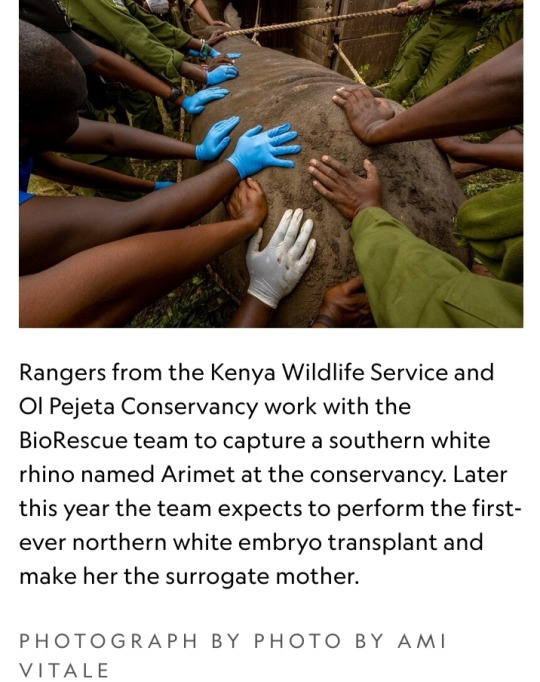
With so few northern white rhinos left, their genetic viability may seem uncertain.
But the BioRescue team points to southern white rhinos, whose numbers likely dropped to less than 100, and perhaps even as few as 20, due to hunting in the late 1800s.
Government protections and intense conservation strategies allowed them to bounce back, and now there are almost 17,000.
“They have sufficient diversity to cope with a wide range of conditions,” says Balfour.
Researchers don’t know exactly how many southern white rhinos existed a century ago, he says, but it’s clear that the animals came back from an incredibly low population count and that they now appear healthy.
Beyond their small collection of embryos, the BioRescue team hopes to expand the northern white rhino’s gene pool by drawing from an unconventional source — skin cells extracted from preserved tissue samples that are currently stored at zoos.
They aim to use stem cell techniques to reengineer those cells and develop them into sex cells, building off similar work in lab mice.
According to their plan, those lab-engineered sex cells would then be combined with natural sperm and eggs to make embryos, and from there, the embryos would be implanted into southern white rhino surrogate mothers.
Such stem cell reprogramming work has previously led to healthy offspring in lab mice, Hildebrandt says, but rhinos aren’t as well-studied and understood as mice, making this work significantly challenging.
A global effort
The northern white rhino revitalization venture has cost millions of dollars, supported by a range of public and private donors, including the German Federal Ministry of Education and Research.
Other partners on the effort include the Leibniz Institute for Zoo and Wildlife Research, the Czech Republic’s Safari Park, Kenya Wildlife Service, Ol Pejeta Conservancy, and also Katsuhiko Hayashi, a professor of genome biology at Osaka University in Japan who conducted the mouse stem cell research.
Building upon Hayashi’s stem cell techniques could ultimately bring the northern white rhino gene pool up to 12 animals — including eggs from eight females and the semen of four bulls, according to Stejskal.
An alternative approach to making more babies, like crossbreeding northern and southern white rhinos, would mean the resulting calves wouldn’t be genetically pure northern white rhinos, Hildebrandt notes.
The two subspecies look quite similar, but the northern version has subtle physical differences, including hairier ears and feet that are better suited to its swampy habitat.
The two animals also have different genes that may provide disease resiliency or other benefits, Hildebrandt says.
There are unknown potential differences in behavior and ecological impact when populating the area with southern white rhinos or cross-bred animals.
"The northern white rhino is on the brink of extinction really only due to human greed,” Stejskal says.
“We are in a situation where saving them is at our fingertips, so I think we have a responsibility to try.”
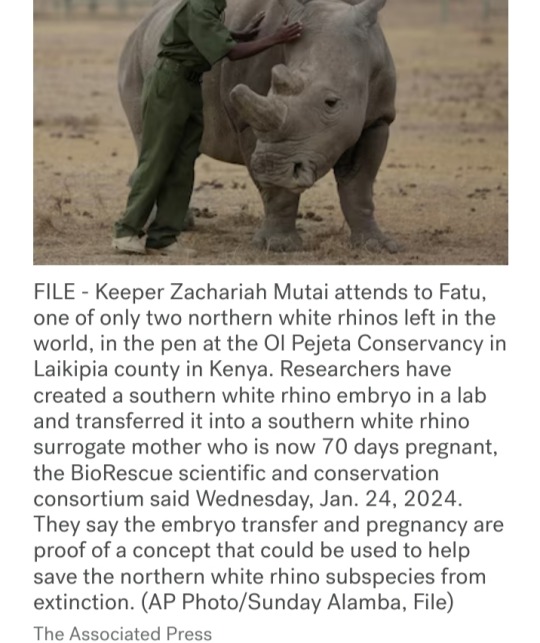
🩶🦏🩶
#northern white rhinoceros#rhino embryo transfer#in vitro fertilization#IVF#southern white rhinoceros#critically endangered animals#National Geographic#BioRescue#rhino horn#International Union for the Conservation of Nature#African rhino specialist group#Thomas Hildebrandt#German Federal Ministry of Education and Research#Leibniz Institute for Zoo and Wildlife Research#Kenya Wildlife Service#Ol Pejeta Conservancy#Katsuhiko Hayashi#genome biology#IVF rhino pregnancy
9 notes
·
View notes
Text
The Kenya Wildlife Service celebrated the successful transfer of 21 eastern black rhinos to establish a new viable breeding population for the species that was on the brink of extinction decades ago.
In an 18-day exercise executed by highly trained capture and veterinary experts, the Loisaba Conservancy received the 21 rhinos from three different locations, becoming the 17th sanctuary in Kenya where the mammoth animals can roam and intermingle.
“It’s incredibly exciting to be part of the resettlement of rhinos to a landscape where they’ve been absent for 50 years,” said Tom Silvester, CEO of Loisaba Conservancy.
Kenya had 20,000 black rhinos in the 1970s before poachers decimated them for their horns. By the time the Kenya Wildlife Service (KWS) was established in 1989, rhino numbers had declined to below 400.
Since then, Kenya’s eastern black rhinos have made a remarkable comeback and today there are an estimated 1,004 individuals.
Kenya is a stronghold of the eastern sub species of black rhino, hosting approximately 80 percent of the entire world’s surviving population.
“Surpassing the milestone of 1,000 rhinos within four decades is a significant accomplishment,” said Munira Bashir, Director of The Nature Conservancy in Kenya.
The reintroduction this month of these 21 animals this month is a great milestone in Kenya’s rhino recovery action plan, and was made possible by support from The Nature Conservancy, San Diego Zoo Wildlife Alliance, other partners—and the three reserves from where the 21 rhinos originated, Nairobi National Park, Ol Pejeta Conservancy and Lewa Conservancy.
“In the recent past, one of the main causes of mortality of rhinos has been territorial fights due to limited space in sanctuaries which has also led to suppressed growth rates due,” explained Dr. Erustus Kanga, the Director General of Kenya Wildlife Service. “I am elated to be associated with this momentous effort to secure more space for this cornerstone species.”
Meanwhile, southern white rhinos continue to thrive in Kenya, having increased from 50 individuals that were imported from South Africa in the eighties and nineties to reach the current population of 971 individuals.
Kenya is also playing a critical role in efforts to save the northern white rhino from extinction, as it is host to the only remaining two females of the species left in the world. The international BioRescue project has developed thirty embryos awaiting implantation into surrogate females within the closely-related subspecies of southern white rhino.
“The return of black rhinos to Loisaba, 50 years after the last known individual here was killed by poachers in the 1970s, is a demonstration of how impactful partnerships between governments and conservation NGOs can be for restoring, managing, and protecting our natural world,” said Dr. Max Graham, CEO and Founder of Space for Giants, one of the project partners.
“And, of course, the return of black rhinos here gives all of us one of the most precious commodities of all: hope.”
-via Good News Network, February 25, 2024
#rhino#rhinoceros#conservation#hope posting#endangered species#wildlife#kenya#good news#hope#zoology#zoo animals#keystone species
353 notes
·
View notes
Photo

[ Northern white rhinoceros “Fatu” and her companion, a Southern white rhinoceros named “Tauwo”, at Ol Pejeta Conservancy. ]
Three years after starting its ambitious program to save the northern white rhino from extinction through advanced assisted reproduction technologies, the BioRescue consortium draws a positive interim conclusion: Following the 10th event of harvesting immature egg cells (oocytes) in the northern white rhino female Fatu, the international team produced five additional embryos—bringing the total to 22 sired by two bulls.
This nourishes the hope to eventually succeed in producing new offspring and give a keystone grazer of Central Africa a new future. At the same time, the consortium places the highest value on respecting the life and welfare of the individual animals involved. Regular veterinary and ethical assessments of oocyte collection procedures show that Fatu handles the procedures well and shows no signs of detrimental health effects.
The 10th oocyte collection in northern white rhinos (NWR) was performed by a team of scientists and conservationists from the Leibniz Institute for Zoo and Wildlife Research (Leibniz-IZW), Ol Pejeta Conservancy, Safari Park Dvůr Králové, Kenya Wildlife Service (KWS) & Wildlife Research and Training Institute (WRTI) on July 28, 2022, at Ol Pejeta Conservancy in Kenya. The BioRescue team was able to collect 23 oocytes from Fatu, the younger of the two remaining NWR females.
- Excerpt from “Consortium announces five new northern white rhinoceros embryos created” by Forschungsverbund Berlin e.V.
#Northern white rhinoceros#Northern white rhino#Mammal#CR#Ol Pejeta Conservancy#Cloning#Conservation#Article#Text#Photo#Live specimen#Captive#Endling#Fatu
71 notes
·
View notes
Quote
科学者と自然保護活動家の国際コンソーシアムである「BioRescue」は、胚移植によるサイの妊娠に世界で初めて成功したそうだ。ケニアのオル・ペジェタ保護区で代理母として選ばれたミナミシロサイに、成功率を高めるため2頭のミナミシロサイの胚を移植。70日後に体長6.4センチのオスの子どもを妊娠していることが明らかになったという(ライプニッツ動物園野生動物研究所、ScienceDaily)。
胎児の組織サンプルは収集され、ドイツのベルリンにあるマックス・デルブリュック分子医学センターとライプニッツ動物園野生動物研究所に送られた。そして2024年1月に胎児のDNA解析により、胚移植による妊娠であることが確認された。この実験は現時点で世界に2頭しか残っていないキタシロサイを救うための概念実証の一環として実施されたという。このサイの胚移植と妊娠の成功は、キタシロサイの胚移植が安全におこなえることを意味しており、キタシロサイを絶滅から救うための重要な一歩となるとしている。
世界初のサイの胚移植に成功。絶滅寸前のキタシロサイを絶滅から救う道が開かれる | スラド サイエンス
1 note
·
View note
Link
0 notes
Link
[ad_1] The fertilized eggs are ready for transfer to wild southern white rhino surrogate mothers, the BioRescue research consortium says A team of scientists working in Kenya announced on Monday that five new embryos have been created to save Africa’s northern white rhino from extinction.BioRescue, the research consortium in charge of the project, said 18 eggs were collected from a female named Fatu in May and fertilized with sperm from two different bulls to improve “genetic diversity.”Fatu and her mother, Najin, are the world’s two remaining northern white rhinos and live on Kenya’s 90,000-acre Ol Pejeta wildlife conservancy, which is under poacher protection.The northern white rhino subspecies was declared functionally extinct in 2018 following the death of the last male, Sudan.“Four years since the start of this ambitious project to save the Northern White Rhino from extinction, the BioRescue consortium has made significant progress towards its ultimate aim,” BioRescue said in a statement.The latest effort by the consortium has yielded the highest number of embryos from any egg collection since the onset of the project.“Previous procedures in November 2022 and February 2023 yielded two and zero embryos, respectively,” it stated.So far, 29 fertilized eggs have been created using advanced assisted reproduction technologies and have been cryopreserved, a process that keeps them at low temperatures for future transfer to surrogate mothers.The consortium said its scientists have identified two wild southern white rhino females as potential surrogate mothers, as both Fatu and Najin are unable to carry a pregnancy to full term. The project is a collaborative effort, with scientists from the Leibniz Institute in Berlin assisting the Kenya Wildlife Service and Ol Pejeta, and the Italian Avantea Laboratory providing fertilization support. It is mainly funded by the German Federal Ministry of Education and Research.Kenya’s Ol Pejeta Conservancy called the development “fantastic news” and commended the team for its “phenomenal dedication and hard work that have made this all possible.” You can share this story on social media: Follow RT on [ad_2]
0 notes
Text
Creati embrioni in Kenya per salvare il rinoceronte bianco
Cinque embrioni di rinoceronte sono stati creati in Kenya per salvare la specie del ‘rinoceronte bianco del nord’ dall’estinzione. Lo ha comunicato sulla sua pagina facebook, Biorescue, progetto finanziato dal governo tedesco che è riuscito a fecondare spermatozoi dell’ultimo esemplare maschio di rinoceronte bianco del nord, ormai deceduto, su Fatu, una delle pochissime femmine della stessa…
View On WordPress
0 notes
Text
Riproduzione assistita per salvare il rinoceronte bianco dall'estinzione
Riproduzione assistita per salvare il rinoceronte bianco dall’estinzione
AGI – Per la prima volta, sono state sviluppate delle cellule germinali primordiali da cellule staminali di rinoceronte bianco settentrionale, scientificamente noto come Ceratotherium simum cottoni. A riuscirci gli scienziati del consorzio BioRescue e dell’Università di Osaka, che hanno pubblicato un articolo sulla rivista Science Advances per rendere noti i risultati del proprio lavoro.
Questo…
View On WordPress
0 notes
Video
I just got to meet the most extraordinary young woman Natalie (@lucky.on.purpose)! She was the winner of the sweepstakes we organized in March to help raise money for @OlPejeta Conservancy and the last two northern white rhinos on the planet, Fatu and Najin, that @olpejeta cares for. She received the trip for two to @OlPejeta Conservancy staying at @asiliaafrica's Ol Pejeta Bush Camp (#olpejetabushcamp), a chance to meet the last two northern white rhinos on the planet, and a brand new @Nikonusa Z 6 and 24-70mm f/4 S lens to capture every unforgettable moment. Together, we raised $200,000 for their care and 10,000 people came forward to support this vital work. Thank you to everyone who was a part of this incredible fundraiser. People like you are why my heart is full of hope for the future of nature. @kenyawildlifeservice @bmbf.bund @biorescue_project @leibnizgemeinschaft @MinistryOfTourismAndWildlifeKE @natgeo @natgeoimagecollection @thephotosociety @nikonusa #NorthernWhiteRhinos #NorthernWhiteRhino #NajinandFatu #WildlifeConservation #OnlyTwoLeft #StopExtinction #EndExtinction #OlPejeta #SavetheChubbyUnicorns #RhinoConservation #StopPoaching #Rhino #biorescue #biodiversity #WorthMoreAlive #OlpejetaRhinos #ProtectRhinos #DontLetThemDisappear #rhinos #Kenya #Africa #photojournalism #amivitale #nikonambassador #nikonlove #nikonnofilter (at Ol Pejeta Conservancy) https://www.instagram.com/p/B5GM1QOBhri/?igshid=rx5x9nlurz8g
#olpejetabushcamp#northernwhiterhinos#northernwhiterhino#najinandfatu#wildlifeconservation#onlytwoleft#stopextinction#endextinction#olpejeta#savethechubbyunicorns#rhinoconservation#stoppoaching#rhino#biorescue#biodiversity#worthmorealive#olpejetarhinos#protectrhinos#dontletthemdisappear#rhinos#kenya#africa#photojournalism#amivitale#nikonambassador#nikonlove#nikonnofilter
15 notes
·
View notes
Link
#africa#anthropause#biodiversity#biorescue#black rhinos#candice gaukel andrews#conservation#coronovirus#covid-19#elephants#endangered species#environment#extinct#extinction#kenya#monarch butterflies#namibia#nature#nature lovers#ol pejeta conservancy#pandemic#poaching#rhino horns#rhino poaching#rhinoceros#rhinos#safari#science#scientific research#tigers
0 notes
Photo

Najin, One of the world’s last two northern white rhinos has been retired on “ethical” grounds from an ambitious breeding programme to save the species from extinction. Scientists at the conservation consortium BioRescue cited risk factors and safety reasons and said that they would stop harvesting 32-year-old Najin’s eggs. “Weighing up risks and opportunities for the individuals and the entire species rendered this decision without an alternative,” BioRescue said #northernwhiterhinorecovery #biorescue (at Ol Pejeta Conservancy) https://www.instagram.com/p/CWAWicLqXSx/?utm_medium=tumblr
0 notes
Text
Test tube embryo transfer may give near-extinct rhinos a second chance
FYI: http://dlvr.it/R7ftx2
0 notes
Text
La mia routine viso post Avvento di Vanity Space
La mia routine viso post Avvento di Vanity Space
Pensavate che il blog si fosse fermato? E invece no! Ogni febbraio ci prendiamo una pausa e ricominciamo la carrellata di articoli con un ritmo di sei al mese come si è sempre fatto. Di che parliamo oggi?
(more…)
View On WordPress
#2017#2018#accettabile#acido#acqua#addolcente#aggressivo#alkemilla#aloe#aurea#avvento#balsamo#bava#beautiful#bio#bioearth#biomed#biorescue#blog#brow#burro#burrocacao#cacao#calendario#capelli#cien#contorno#cosmetics#costanza#cotone
0 notes
Text
We are standing in front of the planet’s last pair of northern white rhinos. Najin and Fatu are mother and daughter. They are kept behind three electric fences at the Ol Pejeta Conservancy in central Kenya, protected at all times by a squad of armed rangers.
With no males left, it’s up to science to step in, but harvesting oocytes, egg cells found in the ovary, from a rhino is a challenging endeavour. A rhino’s ovaries are not much larger than a human fist and are located at least one-and-a-half metres inside a female rhino, hidden behind intestinal loops. Two-inch-thick skin prevents them from being accessed surgically, so instead the BioRescue team have been forced to be creative. They have developed a tube equipped with a long needle which is inserted through the anus. The needle, which is connected to a suction device, pierces the ovaries and, once inside, sucks oocytes down the tube. One slip and you risk inflicting internal bleeding and halving the population of northen whites. And there’s a time limit. A rhino can only be safely sedated for two hours and would likely be none too pleased to wake up with an egg-sucking tube inserted in its anal cavity.
https://www.slow-journalism.com/from-the-archive/saving-the-northern-white-rhino
0 notes
Text
Scientists Create Northern White Rhino Embyros
Scientists Create Northern White Rhino Embyros
Scientists have create embyros of Northern White Rhinos attempting to save their extinction.
Nairobi, Kenya:
One of world’s two remaining live specimens — female Fatu who lives with her mother Najin on Kenya’s 90,000-acre Ol Pejeta wildlife conservancy — provided the eggs for the project, while the sperm used was from two different dead males.
Scientific consortium Biorescue described in a press…

View On WordPress
0 notes